2282
The most terrible plant Planet Earth
Well we live - on lawns only cornflowers yes buttercups. The worst thing that can be seen - yes mushroom nettle. And in the tropical forests can grow plants such dire that you will not know where to escape from them.
1. Bloody tooth / Hydnellum peckii
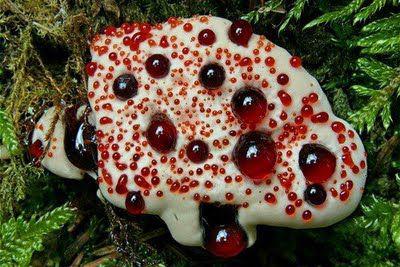
This cute fungus similar to chew gum oozing blood and smelling strawberries. But do not try to eat it, because it will be the last "treat" that you can taste in your life.
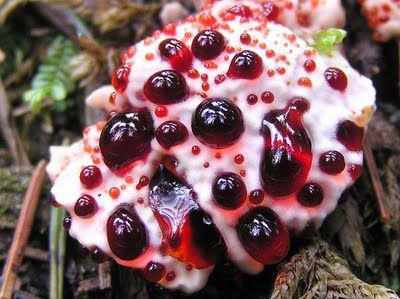
The fungus is known to mankind since 1812 and is considered inedible, ie once, in the dark days of pretemnye lived genius who sacrificed for the glory of the science of his life, in order to warn the children from eating this "delicacy".
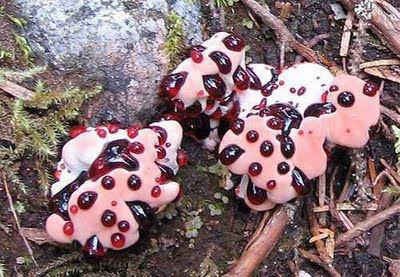
In addition to its outstanding external qualities, this abomination has antibacterial properties and contains chemicals or blood thinners. What can I say, in a short time, this fungus can be a substitute for penicillin (which, incidentally, was removed from the species of the fungus Penicillium notatum). If you do not have enough thrills and you intend in any cost to perpetuate his name in the annals of history (the prize and the title of Darwin's most inept suicide on planet earth you count in the pocket), just lick this natural wonder ...
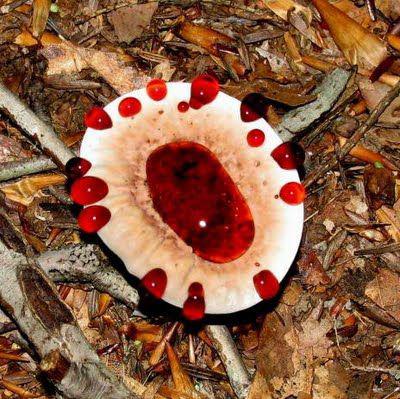
Other names: strawberries and cream (strawberries and cream, dental juice (the red-juice tooth), tooth devil (devil's tooth), tooth fungus bleeding (bleeding tooth fungus).
2. Doll eyes / Doll's Eye

In the best case, this "beauty" is similar to the alien weed, and at worst to the dug-in totem impaled him through human eyes, which a serial killer marked the burial place of all its 666 victims.
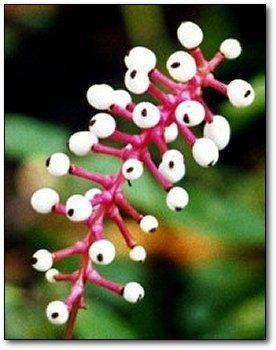
This unusual plant has been called "doll's eyes." There is also less saying the name of this horror - white black cohosh.
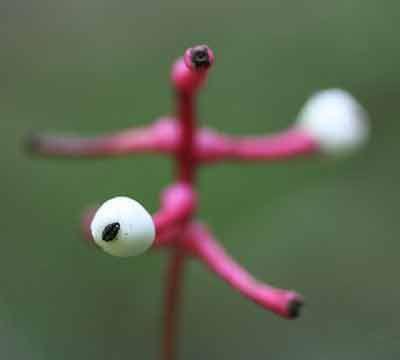
No features other than their appearance this plant does not have, you can even taste it, then tell us about their feelings.
3. Mushroom sea anemones / Sea Anemone Mushroom and "filthy horn octopus" / Octopus Stinkhorn

Sometimes, watching these creations, you begin to wonder about the sanity of the creator. Of course, there are times when and disgusting things reveal themselves to be quite pleasant to the taste, smell ... but this is not the case: the fungus, called "stinking horn octopus", not only looks disgusting, but it stinks, so that can not be described words.

Sometimes, watching these creations, you begin to wonder about the sanity of the creator. Of course, there are times when and disgusting things reveal themselves to be quite pleasant to the taste, smell ... but this is not the case: the fungus, called "stinking horn octopus", not only looks disgusting, but it stinks, so that can not be described words.
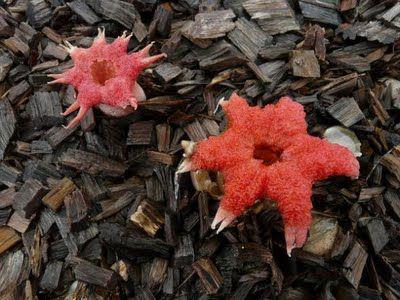
Side-by-side with him in Australia grows and his brother in the stink - mushroom sea anemone, fragrant trupochinoy.
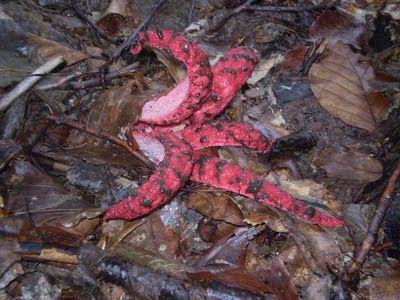
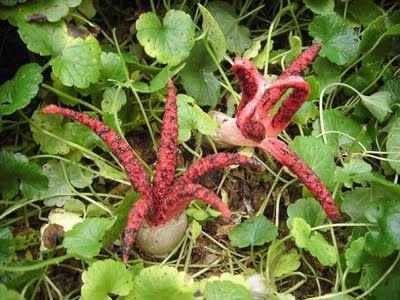
In principle, these fungi are not poisonous, but you're unlikely to be able to try them on taste, because they pose such a fragrance that when you try to cram them into his mouth, you most likely just lose consciousness.
Both fungi are hitryuschie creatures and so as not to end his mortal existence on the sole of his boot hearted Australian, at first their lives, they pretend Below average whitish toadstools. After a while, these cunning begin to bud. The process of transformation into a horrible monster is just a couple of months: during this period pileus is divided into 4-5 pieces, forming a kind of petals.
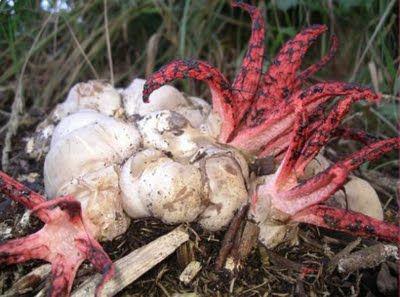
The stench is not only a defense mechanism by gourmets who want to try new taste sensations, but bait for the flies, which are the main carriers of spores of these fungi.
Other names of sea anemones: aseroe rubra, mushroom starfish (starfish fungus).
Other names of "stinking horns octopus": Clathrus archeri.
4. Devil's Claw / Devil's Claw
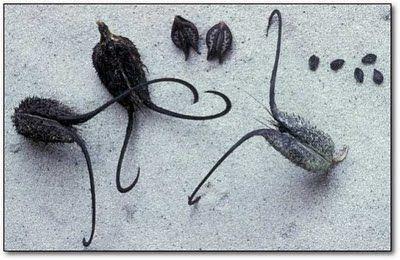
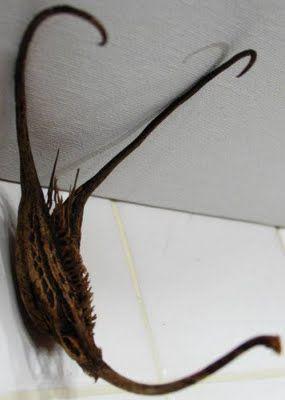
"Devil's Claw" - is something like the thorns of our burr that while running a hand Tagged best friend repeatedly tangled in your hair. The main difference between these two hangers is in appearance: if the thorns burr - cute little balls that just beg to hand, the devil's claw is more like a vicious man-eating spider, which is just waiting to grab you in the throat.
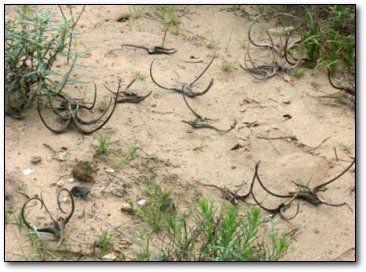

When these demonic contraption "were carried out" only in Arizona, where the native Americans (Indians) are woven baskets and terrifying kind of laid out their entire "minefields" who preferred to get round the enemy. Today "demonic claws" are already fully occupied the whole of the North-west USA. I feel, soon this abomination gets up to Mother Russia, so if you do not want to fall victim to the "devil's claw", start stocking "Roundup" and build barricades pregraditelnye now.

Other names: devil's claw / claw Devil (Devil's Claw).
5. myshetsvet Chinese / Chinese Black Batflowers
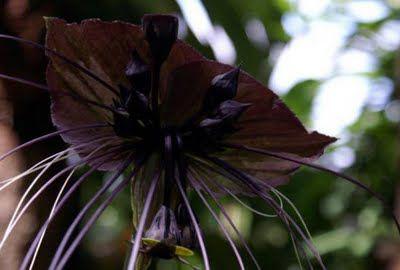
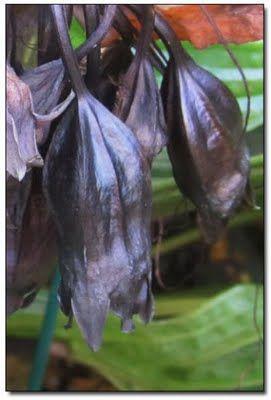
Batman still not randomly selected symbols of criminal intimidation of the population Gotham bat. For these darkspawn terrible: small evil eyes, thin legs with large hooked nogtischami, sharp teeth, plump body, irregularly covered with hair, and huge wings - is not a description of a terrible monster from another low-budget, but no less scary, horror movie? And if you are one of those who think their cute little animals that feed fruktikami, you probably change your mind, when one of these creatures grabbed you in the face and suck up all the drops of your blood ... but, unfortunately, for you will be too late .

Of course, all of this joke in the world there are only a few species of bats that feed on the blood of that attack animals only in his weight class, but agree that playing without a shudder in the heart on the fly through the sky rat is simply impossible.
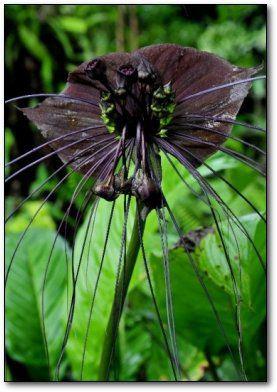
Mother Nature did their best to try to create the most terrible and disgusting at the same plant, endowing it with all the hallmarks of a bat and adding to loyalty beam flagelliform tentacles. This is a product of childhood nightmares became known as Chinese myshetsvet.
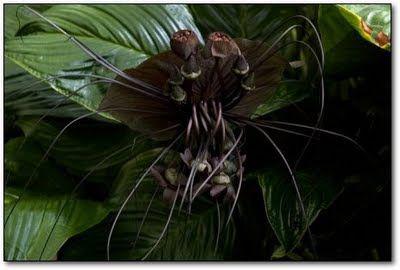
Flower grown exclusively as an ornamental plant brave gardeners who literally cultivated nightmares fertilized human pain, fear and despair. In fact, these people or nerves of steel, or complete lack thereof, because no normal person would not be able to make his stay at the garden of plants that look as though he had just descended from the paintings of unsound mind of the artist, who was trying to draw a vase and use human heads as incubators to nurture their larvae.
6. Hand of Buddha / Buddha's Hand

I do not know what kind of crazy genius decided that this thing is like a hand of Buddha, for me it is something more like a hentai tentacles that are about ohomutat another busty beauty.
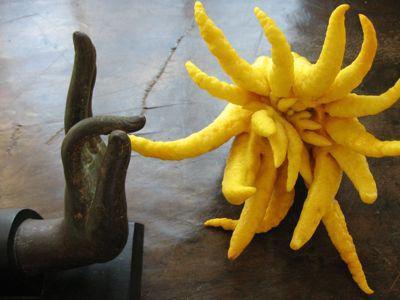
In practice vile tentacles are quite edible, if not delicious, citrus fruits, which is incredibly popular in China and Japan. If you recall the network sortiropodobnyh restaurants, it is not easy to understand why the Chinese baldeyut from eating this gimmick, but from prudish Japanese I did not expect.
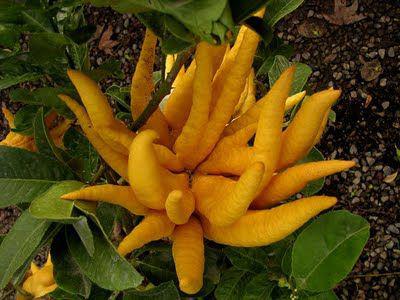
In fact, the hand of the Buddha - a strange kind of lemon, which often peel apart and there is nothing. Fruktina attracts Eastern peoples not only an unusual appearance, but also for its aromatic properties in Japan because it is brewed tea, while China kept the house as a talisman, which brings home good luck, happiness, drives away all evil and bestows longevity. Another of these Limonov tentacles make jam, marmalade and smelling perfume of violets.
And some of the serious: it is generally believed that the Buddha can cleverly wrap, turn off and turn their fingers in time of prayer and at such moments his hands are very similar to those monstrovidnye Lemons.
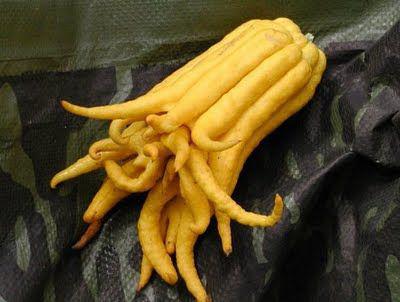
You are what you want, but if this is indeed the case, if I had the opportunity to meet in a dark alley or a good-natured Buddha Freddy Krueger, I would most likely chose the latter.
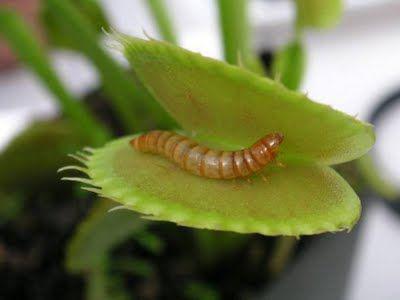
Other names: Citron, tsedrat, Corsican lemon, brush Buddha.
7. Venus Flytrap / Dionaea muscipula
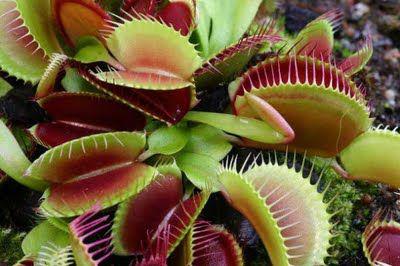

I will assume that no more then a couple of million years ago, these monsters devouring dinosaurs and were the true masters of the planet. But evolution - is the enemy of extremism and all the giants have either died or survived to become more terrestrial measurements, so today flycatcher - a small plant, feed exclusively on insects, caterpillars, slugs and frogs.
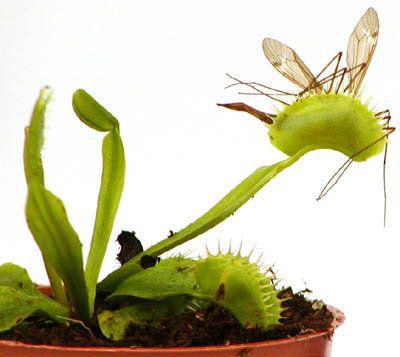
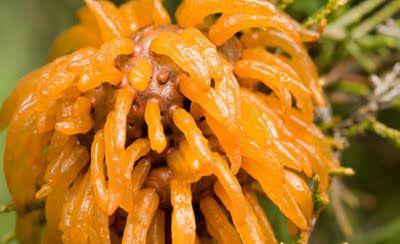
How it works: inside the jaws of leaf-there are many tiny sensory hairs. The victim, crawls on a leaf, these irritating hairs, which in turn give a signal to reduce inner cell of the sheet and the "mouth" begins to close. After some time, the inside of the sheet begins to secrete digestive fluid and exhausted by unsuccessful attempts to get out the victim slowly digested (this process takes a long time. Eg, to digest slug flycatchers take about a week).
Take the time to look on Youtube as a plant eating frogs, grasshoppers ... that's impressive!
8. cedar-apple rotting fungus / Cedar-Apple Rust Fungus
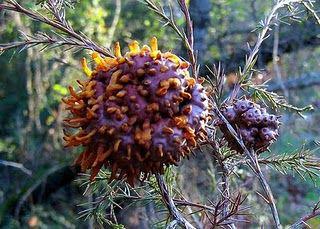
What makes a healthy juicy apple rotting lump vile horror, giving shelter to a whole brood of worms? If your answer to cedar-apple rotting fungus (abbr. KYAGG), then most likely, you will be smart and just read this artful interweaving letters adorning the beginning of the story!
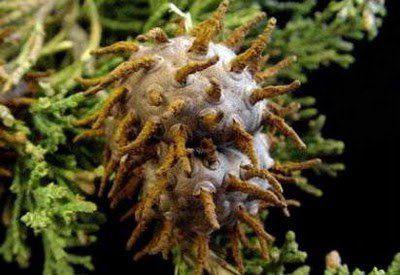
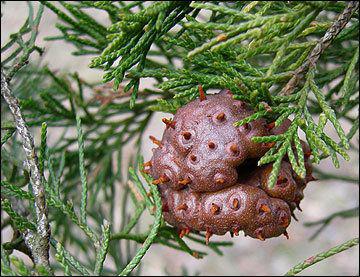
KYAGG - a fungal infection, transforming apple and cedar fruit beyond recognition. About this abomination though right now you can shoot horror: infected fruits in just a few months turn into hideous monsters. Here's how it works: from a tiny fungus spores develop impressive size spherical body - from 3.5 to 5 centimeters in diameter when wet, this abomination is stratified, forming a repulsive mustache. As a result, pine nuts and apples turn into little evil Cthulhu.

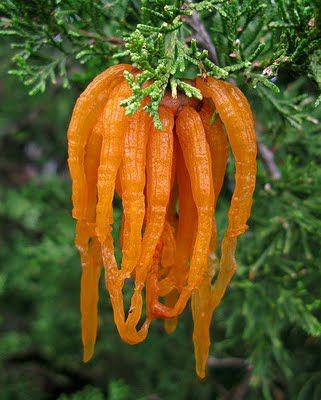
And yes! We strongly recommend that you try them on taste. You never know what :)
9. Rafflesia / Rafflesia
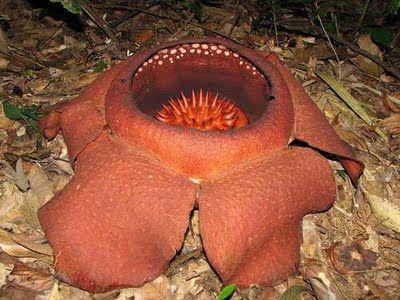
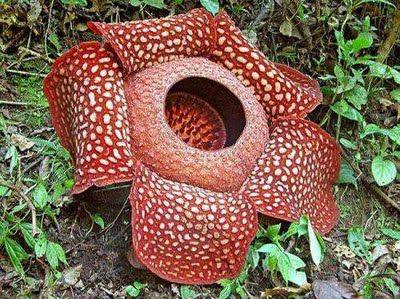
In the photo the kids, eat the incomparable flavors of Rafflesia, which with the same success could push their "light" in the head point of the village public toilets.
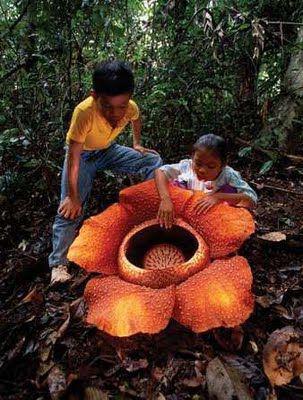

Rafflesia - parasitic plant of the family Euphorbiaceae (Euphorbiacea) with the largest flowers in the world, some of which reach a diameter of one meter and a weight of more than eleven pounds. The parasite spends most of his life in the tissues of the host plant, which acts as a vine of the family Vinogradov growing in tropical rain forests of Indonesia and the Philippines.

It is not unusual plant stem and roots, and its main part is a giant flower with five petals fleshy.
Giant parasite was discovered in 1818, during the expedition of Thomas Stamford Raffles Rafflesia on the island of Sumatra. Found then copy was 1 meter in diameter and weighed 6 pounds. Travelers struck not so much the flower and its incredible size, and a terrible smell of corpses that radiated from him.
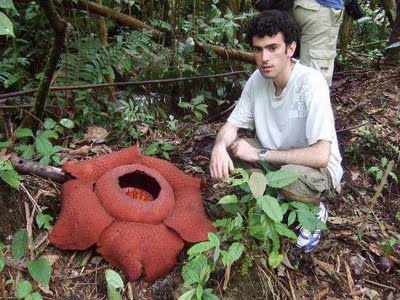
Because of this unusual smell Rafflesia flowers pollinate normal flies. By the way the flowers - the only thing left in the Rafflesia from her relatives - "normal" covered seed plants. Leading a parasitic way of life on the "body" of vines, Rafflesia completely lost any signs of plant - roots, stems, photosynthetic capacity, and all the nutrients parasite gets out of the "body" host.
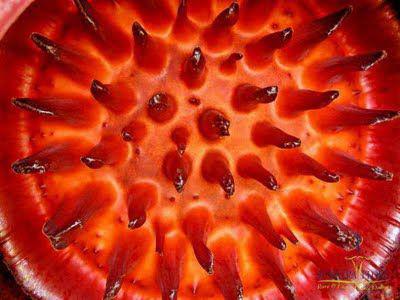
Seedling Rafflesia is gradually introduced into the roots of the host plant with suckers (haustoria). Those parts of the germ, which for some reason were outside the "body" of the host just die. Presumably, the seeds of Rafflesia, awaken to germinate under the influence of discharge potential host plants. These same substances and orient the direction of growth of seedlings.
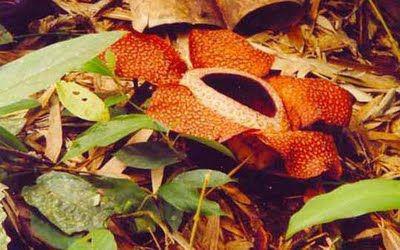
10. Chinese rune flower / Chinese Fleeceflower
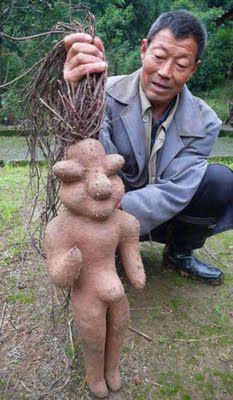
Fruit "runic Flower" have frightening forms through which they look like little potato people.
Chinese uproot these tiny underground inhabitants of the land, in order to use them naked and defenseless body as a panacea for all ills, including impotence, cancer, AIDS, dementia, etc., etc ...
Before you turn into a life-giving powder, men are exposed to various tortures, including: boiling, osvezhevyvanie, soaking in moonshine and dismemberment.
Mark my words, will soon get tired of potatoes Chinese oppression and revolt against the whole of humanity. So some times think before you decide to restore their "mojo" with "runic flower".
11. Porkupinsky tomato / Porcupine Tomato


Porkupinsky tomato - grows in Madagascar polutorametrovy monster whose leaves are covered with fearsome spines orange. It spiked miracle-Yuda incredibly beautiful purple flowers, gathered in clusters, which he lures his victims to himself: and you're lean to rip one of them and find yourself nasazhannymi to "deadly" spikes.
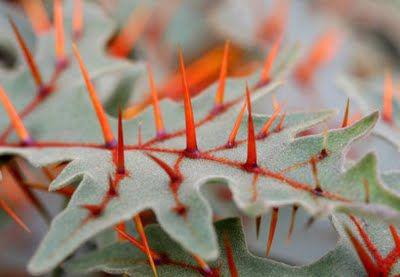
Besides that porkupinsky tomato jerkiness and toxic, it is also virtually impossible to kill: the majority of chemicals nothing to him and he can survive the fierce cold and even a severe drought. As you may have realized this work of nature - monstrous weed, which has set a goal of its existence capture your infield. In a short time, one plant can spawn an army of porkupinskih tomatikov that a few weeks turn into 1.5 meter giants, each of which will fight to the last, and shed not one liter of your blood before being uprooted by the roots out of the ground.
So if your garden filled porkupinskie tomatoes, then do not try to engage them in open battle, but just take away his legs.
1. Bloody tooth / Hydnellum peckii

This cute fungus similar to chew gum oozing blood and smelling strawberries. But do not try to eat it, because it will be the last "treat" that you can taste in your life.

The fungus is known to mankind since 1812 and is considered inedible, ie once, in the dark days of pretemnye lived genius who sacrificed for the glory of the science of his life, in order to warn the children from eating this "delicacy".

In addition to its outstanding external qualities, this abomination has antibacterial properties and contains chemicals or blood thinners. What can I say, in a short time, this fungus can be a substitute for penicillin (which, incidentally, was removed from the species of the fungus Penicillium notatum). If you do not have enough thrills and you intend in any cost to perpetuate his name in the annals of history (the prize and the title of Darwin's most inept suicide on planet earth you count in the pocket), just lick this natural wonder ...

Other names: strawberries and cream (strawberries and cream, dental juice (the red-juice tooth), tooth devil (devil's tooth), tooth fungus bleeding (bleeding tooth fungus).
2. Doll eyes / Doll's Eye

In the best case, this "beauty" is similar to the alien weed, and at worst to the dug-in totem impaled him through human eyes, which a serial killer marked the burial place of all its 666 victims.

This unusual plant has been called "doll's eyes." There is also less saying the name of this horror - white black cohosh.

No features other than their appearance this plant does not have, you can even taste it, then tell us about their feelings.
3. Mushroom sea anemones / Sea Anemone Mushroom and "filthy horn octopus" / Octopus Stinkhorn

Sometimes, watching these creations, you begin to wonder about the sanity of the creator. Of course, there are times when and disgusting things reveal themselves to be quite pleasant to the taste, smell ... but this is not the case: the fungus, called "stinking horn octopus", not only looks disgusting, but it stinks, so that can not be described words.

Sometimes, watching these creations, you begin to wonder about the sanity of the creator. Of course, there are times when and disgusting things reveal themselves to be quite pleasant to the taste, smell ... but this is not the case: the fungus, called "stinking horn octopus", not only looks disgusting, but it stinks, so that can not be described words.

Side-by-side with him in Australia grows and his brother in the stink - mushroom sea anemone, fragrant trupochinoy.


In principle, these fungi are not poisonous, but you're unlikely to be able to try them on taste, because they pose such a fragrance that when you try to cram them into his mouth, you most likely just lose consciousness.
Both fungi are hitryuschie creatures and so as not to end his mortal existence on the sole of his boot hearted Australian, at first their lives, they pretend Below average whitish toadstools. After a while, these cunning begin to bud. The process of transformation into a horrible monster is just a couple of months: during this period pileus is divided into 4-5 pieces, forming a kind of petals.

The stench is not only a defense mechanism by gourmets who want to try new taste sensations, but bait for the flies, which are the main carriers of spores of these fungi.
Other names of sea anemones: aseroe rubra, mushroom starfish (starfish fungus).
Other names of "stinking horns octopus": Clathrus archeri.
4. Devil's Claw / Devil's Claw


"Devil's Claw" - is something like the thorns of our burr that while running a hand Tagged best friend repeatedly tangled in your hair. The main difference between these two hangers is in appearance: if the thorns burr - cute little balls that just beg to hand, the devil's claw is more like a vicious man-eating spider, which is just waiting to grab you in the throat.


When these demonic contraption "were carried out" only in Arizona, where the native Americans (Indians) are woven baskets and terrifying kind of laid out their entire "minefields" who preferred to get round the enemy. Today "demonic claws" are already fully occupied the whole of the North-west USA. I feel, soon this abomination gets up to Mother Russia, so if you do not want to fall victim to the "devil's claw", start stocking "Roundup" and build barricades pregraditelnye now.

Other names: devil's claw / claw Devil (Devil's Claw).
5. myshetsvet Chinese / Chinese Black Batflowers


Batman still not randomly selected symbols of criminal intimidation of the population Gotham bat. For these darkspawn terrible: small evil eyes, thin legs with large hooked nogtischami, sharp teeth, plump body, irregularly covered with hair, and huge wings - is not a description of a terrible monster from another low-budget, but no less scary, horror movie? And if you are one of those who think their cute little animals that feed fruktikami, you probably change your mind, when one of these creatures grabbed you in the face and suck up all the drops of your blood ... but, unfortunately, for you will be too late .

Of course, all of this joke in the world there are only a few species of bats that feed on the blood of that attack animals only in his weight class, but agree that playing without a shudder in the heart on the fly through the sky rat is simply impossible.

Mother Nature did their best to try to create the most terrible and disgusting at the same plant, endowing it with all the hallmarks of a bat and adding to loyalty beam flagelliform tentacles. This is a product of childhood nightmares became known as Chinese myshetsvet.

Flower grown exclusively as an ornamental plant brave gardeners who literally cultivated nightmares fertilized human pain, fear and despair. In fact, these people or nerves of steel, or complete lack thereof, because no normal person would not be able to make his stay at the garden of plants that look as though he had just descended from the paintings of unsound mind of the artist, who was trying to draw a vase and use human heads as incubators to nurture their larvae.
6. Hand of Buddha / Buddha's Hand

I do not know what kind of crazy genius decided that this thing is like a hand of Buddha, for me it is something more like a hentai tentacles that are about ohomutat another busty beauty.

In practice vile tentacles are quite edible, if not delicious, citrus fruits, which is incredibly popular in China and Japan. If you recall the network sortiropodobnyh restaurants, it is not easy to understand why the Chinese baldeyut from eating this gimmick, but from prudish Japanese I did not expect.

In fact, the hand of the Buddha - a strange kind of lemon, which often peel apart and there is nothing. Fruktina attracts Eastern peoples not only an unusual appearance, but also for its aromatic properties in Japan because it is brewed tea, while China kept the house as a talisman, which brings home good luck, happiness, drives away all evil and bestows longevity. Another of these Limonov tentacles make jam, marmalade and smelling perfume of violets.
And some of the serious: it is generally believed that the Buddha can cleverly wrap, turn off and turn their fingers in time of prayer and at such moments his hands are very similar to those monstrovidnye Lemons.

You are what you want, but if this is indeed the case, if I had the opportunity to meet in a dark alley or a good-natured Buddha Freddy Krueger, I would most likely chose the latter.

Other names: Citron, tsedrat, Corsican lemon, brush Buddha.
7. Venus Flytrap / Dionaea muscipula


I will assume that no more then a couple of million years ago, these monsters devouring dinosaurs and were the true masters of the planet. But evolution - is the enemy of extremism and all the giants have either died or survived to become more terrestrial measurements, so today flycatcher - a small plant, feed exclusively on insects, caterpillars, slugs and frogs.


How it works: inside the jaws of leaf-there are many tiny sensory hairs. The victim, crawls on a leaf, these irritating hairs, which in turn give a signal to reduce inner cell of the sheet and the "mouth" begins to close. After some time, the inside of the sheet begins to secrete digestive fluid and exhausted by unsuccessful attempts to get out the victim slowly digested (this process takes a long time. Eg, to digest slug flycatchers take about a week).
Take the time to look on Youtube as a plant eating frogs, grasshoppers ... that's impressive!
8. cedar-apple rotting fungus / Cedar-Apple Rust Fungus

What makes a healthy juicy apple rotting lump vile horror, giving shelter to a whole brood of worms? If your answer to cedar-apple rotting fungus (abbr. KYAGG), then most likely, you will be smart and just read this artful interweaving letters adorning the beginning of the story!


KYAGG - a fungal infection, transforming apple and cedar fruit beyond recognition. About this abomination though right now you can shoot horror: infected fruits in just a few months turn into hideous monsters. Here's how it works: from a tiny fungus spores develop impressive size spherical body - from 3.5 to 5 centimeters in diameter when wet, this abomination is stratified, forming a repulsive mustache. As a result, pine nuts and apples turn into little evil Cthulhu.


And yes! We strongly recommend that you try them on taste. You never know what :)
9. Rafflesia / Rafflesia


In the photo the kids, eat the incomparable flavors of Rafflesia, which with the same success could push their "light" in the head point of the village public toilets.


Rafflesia - parasitic plant of the family Euphorbiaceae (Euphorbiacea) with the largest flowers in the world, some of which reach a diameter of one meter and a weight of more than eleven pounds. The parasite spends most of his life in the tissues of the host plant, which acts as a vine of the family Vinogradov growing in tropical rain forests of Indonesia and the Philippines.

It is not unusual plant stem and roots, and its main part is a giant flower with five petals fleshy.
Giant parasite was discovered in 1818, during the expedition of Thomas Stamford Raffles Rafflesia on the island of Sumatra. Found then copy was 1 meter in diameter and weighed 6 pounds. Travelers struck not so much the flower and its incredible size, and a terrible smell of corpses that radiated from him.

Because of this unusual smell Rafflesia flowers pollinate normal flies. By the way the flowers - the only thing left in the Rafflesia from her relatives - "normal" covered seed plants. Leading a parasitic way of life on the "body" of vines, Rafflesia completely lost any signs of plant - roots, stems, photosynthetic capacity, and all the nutrients parasite gets out of the "body" host.

Seedling Rafflesia is gradually introduced into the roots of the host plant with suckers (haustoria). Those parts of the germ, which for some reason were outside the "body" of the host just die. Presumably, the seeds of Rafflesia, awaken to germinate under the influence of discharge potential host plants. These same substances and orient the direction of growth of seedlings.

10. Chinese rune flower / Chinese Fleeceflower

Fruit "runic Flower" have frightening forms through which they look like little potato people.
Chinese uproot these tiny underground inhabitants of the land, in order to use them naked and defenseless body as a panacea for all ills, including impotence, cancer, AIDS, dementia, etc., etc ...
Before you turn into a life-giving powder, men are exposed to various tortures, including: boiling, osvezhevyvanie, soaking in moonshine and dismemberment.
Mark my words, will soon get tired of potatoes Chinese oppression and revolt against the whole of humanity. So some times think before you decide to restore their "mojo" with "runic flower".
11. Porkupinsky tomato / Porcupine Tomato


Porkupinsky tomato - grows in Madagascar polutorametrovy monster whose leaves are covered with fearsome spines orange. It spiked miracle-Yuda incredibly beautiful purple flowers, gathered in clusters, which he lures his victims to himself: and you're lean to rip one of them and find yourself nasazhannymi to "deadly" spikes.

Besides that porkupinsky tomato jerkiness and toxic, it is also virtually impossible to kill: the majority of chemicals nothing to him and he can survive the fierce cold and even a severe drought. As you may have realized this work of nature - monstrous weed, which has set a goal of its existence capture your infield. In a short time, one plant can spawn an army of porkupinskih tomatikov that a few weeks turn into 1.5 meter giants, each of which will fight to the last, and shed not one liter of your blood before being uprooted by the roots out of the ground.
So if your garden filled porkupinskie tomatoes, then do not try to engage them in open battle, but just take away his legs.





















